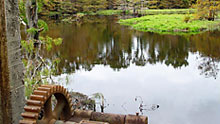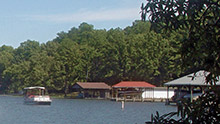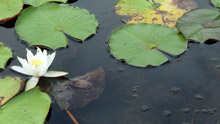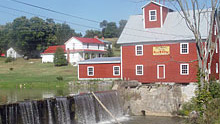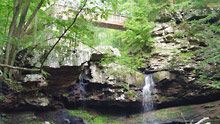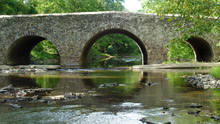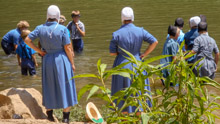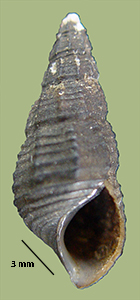Goniobasis or "Elimia" edgariana
> Habitat & Distribution
The range of Pleurocera troostiana (sl), together with all its probable variants, subspecies and synonyms, extends from the Valley-and-Ridge province of SW Virginia and East Tennessee west through the Unglaciated Interior Low Plateau of Middle Tennessee and North Alabama, north into central Kentucky. We have records of P. troostiana (in its broadest sense) from small streams across the entire Tennessee/Cumberland drainage into the Green and Tradewater River drainages of The Ohio.
Isaac Lea gave the habitat of his "Melania edgariana" as "Cany Fork, Tenn," certainly a mis-spelling of Caney Fork, draining north along the western slope of the Cumberland Plateau into the Cumberland River. Goodrich (1940) broadened the range of "Goniobasis edgariana" to "streams of Cumberland, Duck and Elk Rivers, Tennessee." We have records of edgariana (now understood as a subspecies of P. troostiana) throughout the Cumberland drainage of TN/KY, including the Stones, Harpeth, and Obey as well as the Caney/Collins river system. The range of P. troostiana edgariana also includes many tributaries of The Tennessee, including the Elk River of North Alabama and the Duck River of Middle Tennessee.
Within
this region populations primarily
inhabit small, rich, hardwater creeks, although ranging
out into
larger rivers when cool and clear. They even inhabit some
cooler
and clearer reservoirs, such as Center Hill Lake. The FWGNA
incidence rank of all four P. troostiana
subspecies considered together is I-5.
> Ecology & Life History
Bickel (1968) offered a very complete description of the habitat of central Kentucky P. troostiana populations (subspecies lyonii), which he said were "commonly found on firm surfaces in riffle areas but more abundant in shallow spots near shore where water is in motion although slow moving and less turbulent." That is a good description of the habitat of many P. troostiana edgariana populations as well. We should also add that edgariana populations can inhabit the sandy/cobbly shallows of cool reservoirs, below the winter draw-down level.
Bickel also focused a great deal of attention on egg masses, which he figured and described as "plano-convex, 1.3 - 2.0 mm in diameter, and partly covered with fine sand grains." He personally observed eggs "deposited on the undersides of stones" in the month of April, but quoted an unpublished Ph.D. dissertation by W. L. Minkley to the effect that egg masses could be found "July through September, as well as during October, January, and April."
Alas, Bickel did not offer any further observations on life history. But it seems reasonable to expect that two years will be required for maturity, and that several years of iteroparous reproduction can be expected thereafter, as is the case for pleurocerids generally (Dazo 1965). This is life cycle Hi of Dillon (2000: 156 - 162).
> Taxonomy & Systematics
The parent species, Pleurocera troostiana, was originally described by Isaac Lea from the vicinity of Loudon, TN (just south of Knoxville), somewhere around 1838. All populations in East Tennessee bear shells that are variably striate, but never costate. As FWGNA surveys expanded into Middle Tennessee, North Alabama, and Kentucky, however, we discovered populations of P. troostiana inhabiting streams bearing shells that were costate as well as striate.
The appearance of costae on the shells of P. troostiana corresponds strikingly with the distribution of Pleurocera laqueata, a costate species which ranges as far east as Walden Ridge but no further. In my essay of 15Oct24 I presented shell-morphological evidence of troostiana/laqueata hybridization in a small tributary of the Cumberland River east of Nashville, and on 12Nov24 I generalized such findings across a wide variety of species and regions to suggest reticulate evolution in the North American Pleuroceridae. See links below.
For the variably-striate (but uncostate) populations of East Tennessee we suggest retaining the typical nomen Pleurocera troostiana troostiana. For populations bearing lightly costate shells we suggest P. troostiana perstriata, for those bearing heavily costate shells P. troostiana edgariana, and for the variably-shelled populations inhabiting Ohio drainages of central Kentucky P. troostiana lyonii. A complete review of the elaborate taxonomy of Pleurocera troostiana is available as a download here [pdf].
Originally described in the genus Melania, Tryon (1873) transferred edgariana to Goniobasis and synonymized it under G. nassula (Conrad 1834). Goodrich (1940) resurrected the nomen out from under synonymy and listed 13 synonyms underneath it. Burch transferred edgariana from Goniobasis to "Elimia," but otherwise transmitted the Goodrich system uncritically. We demoted edgariana to subspecific status under troostiana in our essay of 5June20. Melania costulata (Lea 1841) is a junior synonym.
This species has travelled through three genera in thirty years. Although predominantly assigned to Goniobasis through most of the 20th century, in the 1980s many workers began placing it in the resurrected generic nomen, "Elimia." Both Goniobasis and Elimia were subsumed under Pleurocera by Dillon (2011). See my essay of 23Mar11 from the link below for more.
> Maps and Supplementary Resources
- Dillon, R. T., Jr. (2020) The four subspecies of Pleurocera troostiana (Lea 1838), with synonymy. FWGNA Circular 2: 1 -5. [pdf]
- Distribution of P. troostiana in the Tennessee/Cumberland (2022)
- Pretty photo of living P. troostiana edgariana, courtesy of Chris
Lukhaup.
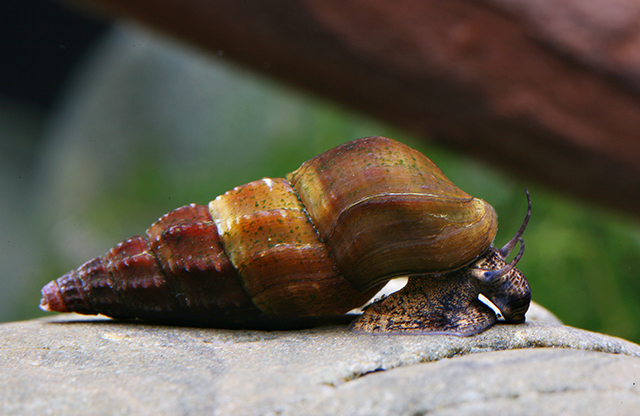
> Essays
- Taxonomic controversy has surrounded the generic nomina Pleurocera, Goniobasis, and Elimia for many years. The best entry into the subject would be my essay of 23Mar11, entitled Goodbye Goniobasis, Farewell Elimia. Links are available from that essay to older resources.
- In my blog post of 4Aug19, "CPP Diary: Yankees at The Gap," I documented a striking case of cryptic phenotypic plasticity in the population of P. troostiana inhabiting a little stream that runs south out of Cumberland Gap, TN.
- I used the Melania troostiana situation as an example of why Isaac Lea Drives Me Nuts in November of 2019.
- The evidence that troostiana is the oldest available name for this entire far-flung and variable species was reviewed in 6Dec19, On the Trail of Professor Troost. And I reviewed the evidence that seven other East Tennessee nomina should be considered its junior synonyms in my post of 7Jan20, CPP Diary: The Many Faces of Professor Troost.
- I proposed and justified the (predomiantly Cumberlandian) subspecies edgariana in my essay of 5June20, What is Melania edgariana. See that essay for a reproduction of Lea's original (1843) figure, and a selection of recently collected topotypes and near-topotypes.
- In my essay of 15Oct24 I presented shell morphometric evidence that populations identified as P. troostiana perstriata result from Widespread hybridization between Pleurocera laqueata and P. troostiana in streams of the Tennessee/Cumberland. That essay also featured a nice map comparing the distributions of all four troostiana subspecies to that of P. laqueata.
- And in my follow-up essay of 12Nov24 I generalized evidence of such hybridization across a variety of species and regions to suggest Reticulate evolution in the North American Pleuroceridae.
- Given the levels of hybridization documented in the essays linked above, we should not be surprised to discover that a wonderful tower of taxonomic babel has been erected to capture the rich variety of shell morphological variation associated. See my review of 10Dec24, Taxonomy Part I, for images of the holotypes of edgariana and its junior synonym costulata (Lea 1841).
> References
Bickel, D.
(1968) Goniobasis curreyana lyoni,
a pleurocerid snail of west-central Kentucky. The Nautilus 82: 13 - 18.
Branson, B.A. (1987)
Keys to the aquatic gastropoda known from
Kentucky. Trans. Kentucky Acad. Sci. 48: 11 - 19.
Burch, J. B. (1989)
North American Freshwater Snails.
Malacological Publications, Hamburg, Michigan. 365
pp.
Conrad, T. A. (1834) New
Fresh Water Shells of the United States, with coloured illustrations,
and a monograph of the genus Anculotus of Say; also A synopsis of the
American naiades. Philadelphia, Judah Dobson. 76 pp, 8
plates.
Dazo, B. C. (1965) The morphology and natural history of Pleurocera acuta
and Goniobasis livescens
(Gastropoda: Cerithiacea: Pleuroceridae). Malacologia 3: 1 -
80.
Dillon, R.
T., Jr. (1989) Karyotypic evolution in
pleurocerid snails: I. Genomic DNA estimated by flow cytometry.
Malacologia, 31: 197-203.
Dillon, R. T., Jr. (2000)
The Ecology of Freshwater Molluscs. Cambridge, Cambridge University
Press. 509 pp.
Dillon, R. T., Jr. (2011) Robust
shell phenotype is a local response to stream size in the genus Pleurocera
(Rafinesque, 1818). Malacologia 53: 265-277.
Dillon, R. T. Jr.,
& K. B. Davis (1991) The diatoms
ingested by freshwater snails: temporal, spatial, and interspecific
variation. Hydrobiologia 210: 233-242.
Dillon, R. T., Jr.,
& J. D. Robinson (2007a) The Goniobasis ("Elimia") of
southwest Virginia, I. Population genetic survey. Report to
the Virginia Division of Game & Inland Fisheries, 25
pp. [PDF]
Goodrich, C. (1913)
Spring collecting in southwest Virginia. Nautilus 27: 81-82,
91-95.
Goodrich, C. (1935)
Studies of the gastropod family Pleuroceridae V.
Occas. Pprs. Mus. Zool. Univ. Mich., 318: 1 - 12.
Goodrich, C. (1940)
The Pleuroceridae of the Ohio River drainage system. Occas.
Pprs. Mus. Zool. Univ. Mich., 417: 1-21.
Graf, D. L. (2001)
The cleansing of the Augean stables.
Walkerana 12(27): 1 - 124.
Jokinen, E.H. 1992. The Freshwater Snails (Mollusca:
Gastropoda) of New York State. NY State Mus Bull 482, Albany, New York.
Lea, Isaac (1838-39)
Description of New Freshwater and Land Shells. Transactions of
the American Philosophical Society (New Series) 6: 1 154.
Lea, Isaac (1841)
Continuation of Mr. Lea's paper on New Fresh Water and Land
Shells. Proceedings of the American Philosophical Society 2: 11
15.
Lea, Isaac (1843)
Description of New Fresh Water and Land Shells. Transactions of
the American Philosophical Society (New Series) 8: 163 250.
Scudder, N. P. (1885)
Bibliographies of American naturalists - II. The published
writings of Isaac Lea, LL.D. Bullentin of the US National
Museum
23: 1 - 278.
Smith, D.G. 1980.
Goniobasis virginica
(Gastropoda: Pleuroceridae) in the Connecticut River USA. Nautilus
94:50-54.
Stewart, T. W., &
R. T. Dillon, Jr. (2004) Species
composition and geographic distribution of Virginia's freshwater
gastropod fauna: A review using historical records. Am.
Malac. Bull. 19: 79-91.
Tryon, G. W. (1873)
Land and Freshwater shells of North America Part IV,
Strepomatidae. Smithsonian Miscellaneous Collections 253: 1 -
435.
Wetherby, A.G. (1876)
Remarks on the variation in form of the family Strepomatidae, with
descriptions of news species Proceedings of the Cincinnati
Society of Natural History 1:10.

